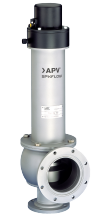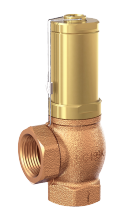Safety valves are crucial for safeguarding industrial systems from overpressure. They come in various types, including spring-loaded, pilot-operated, and balanced bellows safety valves. Spring-loaded valves use a spring to exert force against the pressure, while pilot-operated valves use system pressure to control the opening force. Balanced bellows valves utilize a bellows element to balance the pressure, ensuring accurate and reliable operation. These diverse types cater to different applications, providing essential protection and ensuring system integrity.



Safety Valves
4 series from 2 manufacturers
-
- Analysis
- Circulation
- Cleaning
- Control
- Conveying
- Cooling
- Descaling
- Desinfection
- Dewatering
- Diagnostic
- Discharge
- Distribution
- Dosing
- Drain
- Drainage
- Dredging
- Dual Dispensing
- Extraction
- Feed
- Filling
- Filtration
- Flow Control
- Greasing
- Grinding
- Handling
- Heating
- High-Pressure
- High-Temperature
- High-Volume
- Injection
- Irrigation
- Level Control
- Lift
- Lifting
- Loading
- Low-Pressure
- Lubrication
- Medium-Pressure
- Off-loading
- Powder Coating
- Pressurisation
- Process
- Processing
- Recirculation
- Recovery
- Refueling
- Replacement
- Rinsing
- Sampling
- Settling
- Spraying
- Tempering
- Transfer
- Treatment
- Unloading
- Volumetric Dispensing
- Washing
- Water-Jet Cleaning
-
- Adjustable-Flow
- Automatic
- Chemically Resistant
- CIP
- Compact
- Containment
- Corrosion-Proof
- Electric
- Flange
- Heavy-Duty
- High System Pressure
- High Temperature
- High-Flow
- Horizontal Mount
- In-Line
- Low Shear
- Mechanical
- Modular
- Motorless
- Oil-Free
- Pneumatic
- Pulse-less
- Sanitary
- SIP
- Solids Handling
- Vertical
- Vertical-Mount
The Operating Principle of a Safety Valve
The operating principle of a safety valve revolves around the concept of relieving excessive pressure within a system to prevent catastrophic failures. When the pressure within the system surpasses a predetermined threshold, the safety valve initiates its operation.
In a spring-loaded safety valve, the force exerted by the compressed spring keeps the valve closed under normal operating conditions. However, when the system pressure exceeds the set limit, it overcomes the spring force, causing the valve to lift off its seat. This lifting action creates an opening through which the excess pressure can escape, diverting it away from the system and thus preventing potential damage. Once the pressure decreases to a safe level, the spring force reseats the valve, restoring normal operation.

Similarly, in a pilot-operated safety valve, the system pressure acts on a piston or diaphragm connected to the valve, counterbalanced by a spring force and controlled by a pilot valve. When the system pressure exceeds the set limit, the pilot valve opens, allowing the pressurized fluid to act on the piston or diaphragm, which lifts the main valve to relieve the excess pressure. This mechanism ensures precise control over the opening and closing of the safety valve, maintaining system safety and integrity.
Advantages & Disadvantages of Safety Valves
Safety valves play an important role in safeguarding industrial processes by automatically releasing excess pressure, ensuring system integrity and personnel safety. Understanding their advantages and disadvantages is essential for effective pressure management and risk mitigation in various applications.
Advantages of Safety Valves
Safety valves offer critical protection by automatically relieving excess pressure, preventing potential equipment damage or catastrophic failures.
- Pressure Relief: Safety valves act as a crucial safeguard by automatically venting excess pressure from systems, preventing potential equipment damage or catastrophic failures due to overpressure.
- Continuous Monitoring: These valves offer ongoing pressure monitoring, ensuring that pressure levels remain within safe limits even during unforeseen fluctuations or variations in operating conditions.
- Versatility: Safety valves find application across diverse industries and processes where precise pressure regulation is vital, including steam boilers, pressure vessels, pipelines, and various process equipment.
- Automatic Operation: Operating autonomously, safety valves respond promptly to pressure changes without requiring manual intervention, thereby bolstering system safety and reliability.
Disadvantages of Safety Valves
Despite their importance, safety valves can face challenges such as reliability issues, pressure loss upon activation, and complexity in certain designs. These factors necessitate careful installation, maintenance, and regular inspection to mitigate risks effectively.
- Limited Reliability: The reliability of safety valves can be compromised due to factors such as improper installation, maintenance issues, or mechanical failures, potentially leading to inadequate pressure relief and vulnerabilities in the system.
- Pressure Loss: Activation of safety valves results in the discharge of pressurized fluid from the system, leading to pressure loss and possible disruptions in process operations.
- Complexity: Certain safety valve designs, particularly pilot-operated valves, can be intricate and demand specialized knowledge for proper installation, operation, and maintenance, adding complexity to the system.
- Overpressure Risks: In scenarios such as valve malfunction or improper sizing, safety valves may fail to adequately relieve pressure, posing risks of overpressure and consequential damage to the system. Regular inspection and testing are imperative to mitigate such risks and ensure optimal valve performance.
Important consideration when Selecting a Safety Valve
When selecting a safety valve, several key considerations should be taken into account to ensure optimal performance and system safety:
- Pressure Rating: Choose a safety valve with a pressure rating suitable for the maximum operating pressure of your system to ensure effective pressure relief.
- Set Pressure: Determine the appropriate set pressure, which is the pressure at which the safety valve opens to relieve excess pressure. It should be set slightly above the maximum operating pressure to prevent frequent activation while ensuring adequate protection.
- Overpressure Protection: Evaluate the safety valve's ability to provide reliable overpressure protection by considering factors such as response time, reseating pressure, and stability to prevent system damage or failure during pressure surges.
- Flow Capacity: Consider the flow capacity or relieving capacity of the safety valve, which is the maximum flow rate it can handle when relieving pressure. Ensure that the selected valve can handle the anticipated fluid flow under worst-case scenarios.
- Operating Environment: Evaluate the operating conditions, including temperature, fluid type, and corrosiveness, to select a safety valve made from compatible materials that can withstand the environment without degradation.
Why buy Safety Valves from AxFlow
Safety valves play a critical role in maintaining system integrity by automatically relieving excess pressure. At AxFlow, we offer a wide selection of safety valves designed to meet the demanding requirements of various industries. With our team of experienced engineers and partnerships with top manufacturers, we provide tailored solutions to ensure optimal pressure relief and system safety. Whether you need assistance with selection, installation, or maintenance, AxFlow is committed to providing reliable support for your needs.






